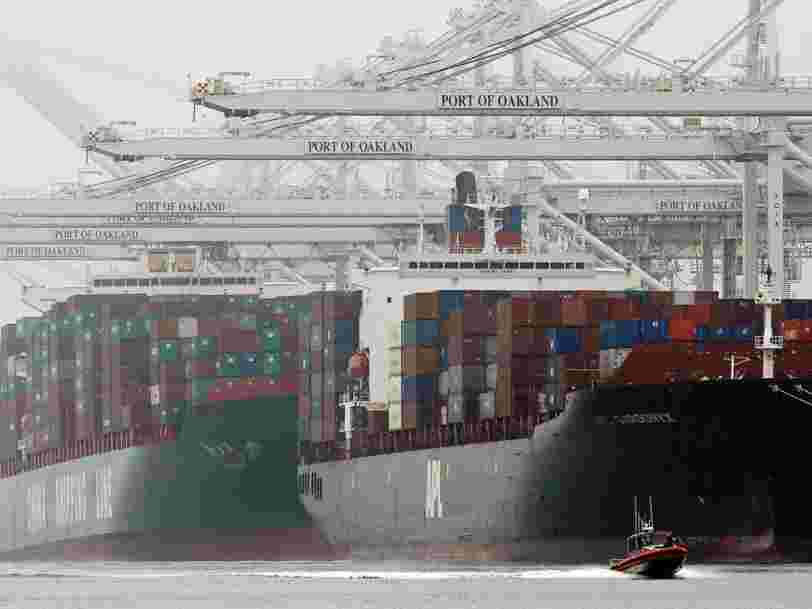California ports aren't the only ones facing record backlogs of cargo ships - 3 other US ports have hit historic highs
Grace Kay | Publié le
- Ports in New Jersey and New York, as well as in Texas and Georgia, have seen record pileups.
- Turnaround time for container ships has increased across the country.
- Southern California ports face the greatest delays as they handle nearly half of all US imports.
- See more stories on Insider's business page .
Shipping delays are piling up across the country as multiple US ports hit record backlogs.
As the largest source of imports in the US - responsible for nearly half of all incoming goods - Southern California ports have received widespread attention. The ports have over 60 hulking cargo ships line up along the shore waiting to dock and unload. But, several smaller ports are also feeling the pinch.
In the Port of Savannah - the fourth largest US port - over 20 container ships are waiting to dock. The port has hit multiple records this year for the number of container ships that have passed through the location. In July, Associated Press reported that the port moved 5.3 million 20-foot containers in a fiscal year - the most the location has ever encountered in a single year.
Georgia Ports Authority did not respond to a request for comment from Insider, but Executive Director of the Georgia Ports Authority Griff Lynch told The Wall Street Journal that the boom in e-commerce has contributed to the backlog of cargo ships.
"Because of all this extra freight being imported, it's creating a backlog from the ship side to the dock side to warehouses and across the whole supply chain," Lynch told The Journal.
Earlier this week, Georgia Ports Authority approved a $34 million plan to help solve the port delays by adding space to include another 1.6 million 20-foot shipping containers.
Rising cargo volumes moving through smaller ports show how diverting traffic from Southern California is not a viable option
In August, Port Houston set a new record for the number of shipping containers that went through the port over the course of the month as over 320,000 20-foot containers passed through the location - a number 29% higher than the same time the year before, when shipping levels were already spiking. A Port Houston spokesperson did not respond to a request for comment, but the group addressed the new record in a press release earlier this month.
"We expect elevated levels in the supply chain to continue well into 2022 and will continue to explore opportunities including accelerating an already aggressive capital investment strategy for our terminals to stay in front of the demand," said Roger Guenther, executive director at Port Houston.
The Port of New Jersey and New York, which handles the majority of imports to the East Coast, hit a record number of cargo for its 13th consecutive month in August. Over 780,000 shipping containers passed through the port that month, according to a press release . Earlier this week, the Port of New York and New Jersey had 9 cargo ships at anchor , but a port spokesperson told Insider all of the ships were expected to dock within 48 hours.
"There are no labor shortages or significant shipping backlogs. The majority of the ships anchored off the coast of the Port of New York and New Jersey are oil tankers that do not call at Port Authority of New York and New Jersey facilities," the spokesperson told Insider. "During September, and throughout the pandemic, the port has performed extraordinarily well in keeping the supply chain moving throughout the region, as well as cargo bound for the Midwest via rail."
Despite record-breaking levels in smaller ports, Southern California ports still face the greatest backlogs
A report from the RBC Capital Markets and Orbital Insight that analyzed the top 22 most influential ports in the world found that 77% of the locations had produced above average wait times this year. It found that the ports in Southern California had the most inefficient wait times of any other top port in the world. The turnaround time for a container in the ports nearly doubled in 2021 as compared to averages seen in 2017 through 2019.
The time it takes for a ship to enter the port and unload increased from 3.6 days to 6.4 days in the Southern California ports - nearly five days longer than several ports in Asia which operate 24/7. What's more, wait times at the port have recently exploded, with some boats waiting as long as three weeks before they can dock.
In contrast, levels at East Coast ports have been more stable as New York and New Jersey, as well as Port Houston ports, only saw an average increase equivalent to a quarter of a day. The study did not take the Port of Savannah into consideration.
The study identified the greatest difficulty at Long Beach and Los Angeles ports as the lack of foot traffic which remains 28% below pre-pandemic levels.
"We were able to quantify the degree of the worker shortage that takes place by measuring foot traffic," Mike Tran, managing director of global energy strategy and digital intelligence strategy at RBC Capital Markets, told Insider. "Container ships are carrying about 30% more goods, which means more to unload, but now they have to do it with 28% less people."
Tran told Insider that the only way he sees the supply-chain crisis resolving itself would be if people limited the amount of goods they purchased - an unlikely outcome considering the impending holiday shopping season paired with many companies' need to restore depleted inventory levels.
Via PakApNews